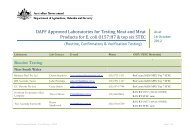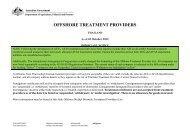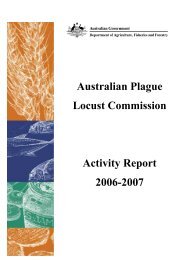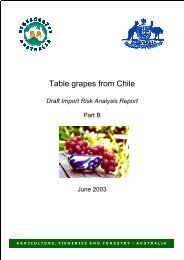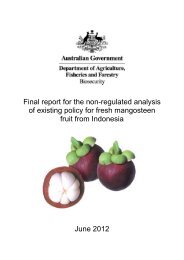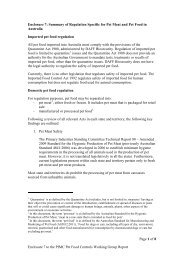Creating Appetite for Farmers' Markets in Australia
Creating Appetite for Farmers' Markets in Australia
Creating Appetite for Farmers' Markets in Australia
You also want an ePaper? Increase the reach of your titles
YUMPU automatically turns print PDFs into web optimized ePapers that Google loves.
NATIONAL FOOD PLAN SUBMISSION<br />
<strong>Creat<strong>in</strong>g</strong> <strong>Appetite</strong> <strong>for</strong><br />
Farmers’ <strong>Markets</strong> <strong>in</strong> <strong>Australia</strong><br />
Further <strong>in</strong><strong>for</strong>mation please contact:<br />
Jane Adams<br />
<strong>Australia</strong>n Farmers’ <strong>Markets</strong> Association<br />
PH (02) 9360 9380<br />
Email: jacom@bigpond.net.au<br />
www.farmersmarkets.org.au<br />
• AUSTRALIAN FARMERS MARKETS’ ASSOCIATION * PO BOX 1101 POTTS POINT NSW 2011
NATIONAL FOOD PLAN – AUSTRALIAN FARMERS’ MARKETS ASSOCIATION SUBMISSION<br />
OVERVIEW<br />
This submission is predicated on two basic facts:<br />
… Food is fundamental to survival<br />
… Exist<strong>in</strong>g food systems and food policies do not necessarily offer the most<br />
susta<strong>in</strong>able options <strong>for</strong> feed<strong>in</strong>g <strong>Australia</strong>’s citizens.<br />
And a realisation – market places are as old as mank<strong>in</strong>d.<br />
It seeks recognition of a place <strong>for</strong> farmers’ markets <strong>in</strong> contemporary and future urban and rural<br />
<strong>Australia</strong>n communities and national policy frameworks that facilitate the establishment and<br />
susta<strong>in</strong>able operation of farmers’ markets.<br />
FARMERS’ MARKETS<br />
… contribute positively to <strong>Australia</strong>’s food policy delivery,<br />
food security and national good health.<br />
… are a relatively new l<strong>in</strong>k <strong>in</strong> <strong>Australia</strong>’s food cha<strong>in</strong><br />
… epitomise and practice ‘paddock to plate’ food provision<br />
This submission seeks to alert government to the power, pert<strong>in</strong>ence and practical solutions <strong>for</strong><br />
national food policy provided by the vibrant network of farmers’ markets trad<strong>in</strong>g regularly <strong>in</strong> all<br />
states <strong>in</strong> <strong>Australia</strong>.<br />
There are over 150 farmers’ markets trad<strong>in</strong>g <strong>in</strong> capital cities, regional centres, and country<br />
towns from Carnarvon, WA, to Byron Bay, NSW, and beyond.<br />
FARMERS’ MARKET DEFINITION<br />
A farmers’ market is def<strong>in</strong>ed as:<br />
‘A predom<strong>in</strong>antly fresh food market that operates regularly with<strong>in</strong> a community, at a focal public<br />
location that provides a suitable environment <strong>for</strong> farmers and food producers to sell farm-orig<strong>in</strong><br />
and associated value-added processed food products directly to customers.’<br />
AUSTRALIAN FARMERS’ MARKETS ASSOCIATION
NATIONAL FOOD PLAN – AUSTRALIAN FARMERS’ MARKETS ASSOCIATION SUBMISSION<br />
FIRST CROP –<br />
CHARTING THE EVOLUTION OF FARMERSʼ MARKETS IN AUSTRALIA<br />
The first farmers’ market <strong>in</strong> <strong>Australia</strong> started trad<strong>in</strong>g <strong>in</strong> 1999. At last count there were 150-plus<br />
operat<strong>in</strong>g <strong>in</strong> all states with constant enquiry <strong>for</strong> new start markets.<br />
The movement is qu<strong>in</strong>tessentially a grassroots creation where likem<strong>in</strong>ded <strong>in</strong>dividuals have<br />
jo<strong>in</strong>ed together <strong>in</strong> vary<strong>in</strong>gly <strong>for</strong>med and constituted groups to start community-based food<br />
markets. They have sprung up <strong>in</strong> shopp<strong>in</strong>g malls, showgrounds, racetracks, warehouses, and<br />
car parks where a collection of tents, trestles and trucks collect on specific half-days (mostly<br />
morn<strong>in</strong>gs), a temporary <strong>in</strong>frastructure that allows farmers, their families and artisan producers to<br />
directly sell their edible wares to shoppers hungry <strong>for</strong> fresh food straight from its source. It is this<br />
direct through-cha<strong>in</strong> relationship – food sold directly from producer to consumer, the<br />
market’s food focus, and the prom<strong>in</strong>ence of fresh food that essentially def<strong>in</strong>es a farmers’<br />
market.<br />
The drivers <strong>for</strong> the rapidly grow<strong>in</strong>g farmers’ market movement have varied from state to state<br />
but encompass stimuli as varied as food groups, church organisations, ma<strong>in</strong> streets<br />
committees, state economic development departments, local government, health promotions,<br />
farm<strong>in</strong>g associations, organic growers, agribus<strong>in</strong>ess networks and commercial private market<br />
operators.<br />
The Bullet<strong>in</strong> cover story <strong>in</strong> May 2002 was a critical turn<strong>in</strong>g po<strong>in</strong>t <strong>in</strong> the evolution of the farmers’<br />
market movement – f<strong>in</strong>ally the ‘Real Food Revolution’ was on newsstands. Subsequent media<br />
coverage has highlighted both the power and popularity of farmers’ markets as <strong>Australia</strong>n<br />
consumers began to discover an alternative way to buy food, other than shopp<strong>in</strong>g at<br />
supermarkets.<br />
Other critical milestones have <strong>in</strong>cluded national farmers’ market conferences (2003, 2005,<br />
2009), provid<strong>in</strong>g a <strong>for</strong>um <strong>for</strong> people active <strong>in</strong> the movement or want<strong>in</strong>g to discover the benefits<br />
of farmers’ markets.<br />
The <strong>Australia</strong>n Farmers’ <strong>Markets</strong> Association (AFMA) www.farmersmarkets.org.au was<br />
established <strong>in</strong> 2003 and the Victorian Farmers <strong>Markets</strong> Association <strong>in</strong> 2006.<br />
www.vicfarmersmarket.org.au<br />
<strong>Australia</strong>n Farmers’ <strong>Markets</strong> Association, August 2011<br />
PO Box 1101 Potts Po<strong>in</strong>t NSW 2011 Email: jacom@bigpond.net.au<br />
3
NATIONAL FOOD PLAN – AUSTRALIAN FARMERS’ MARKETS ASSOCIATION SUBMISSION<br />
SECOND CROP – CONTRIBUTIONS AND POSITIVE OUTCOMES<br />
The evolution of farmers’ markets has now established real momentum with a recognised social<br />
footpr<strong>in</strong>t. There are various markers <strong>for</strong> this status which <strong>in</strong>clude:<br />
The evolution of farmers’ markets has now established real momentum with a recognised social<br />
footpr<strong>in</strong>t. There are various markers <strong>for</strong> achiev<strong>in</strong>g a critical success status that should underp<strong>in</strong>,<br />
and will support the vision <strong>for</strong> <strong>Australia</strong>’s food sector, as outl<strong>in</strong>ed <strong>in</strong> the Issues paper – National<br />
Food Plan 2011.These <strong>in</strong>clude:<br />
Government<br />
This Stand<strong>in</strong>g Committee on Environment and Heritage ‘Susta<strong>in</strong>able Cities 2025’ enquiry<br />
accepted a submission from the <strong>Australia</strong>n Farmers’ <strong>Markets</strong> Association. The Victorian State<br />
Government has provided fund<strong>in</strong>g support, and ABARES has commissioned national research<br />
<strong>in</strong>to farmers’ markets. Victorian DPI facilitated the publication of a generic model <strong>for</strong> farmers’<br />
markets, an extension of a Victorian agribus<strong>in</strong>ess feasibility study. The VFMA operates regular<br />
<strong>in</strong><strong>for</strong>mation and skills workshops <strong>for</strong> market managers and market vendors.<br />
Rural and Urban Development<br />
Evidence suggests that some property developers are consider<strong>in</strong>g <strong>in</strong>corporat<strong>in</strong>g market spaces<br />
<strong>in</strong>to development plans <strong>for</strong> public and urban space. In addition both State and Local government<br />
has entered the farmers’ market sector. Notably, Redfern Waterloo Authority (NSW) operates<br />
the award-w<strong>in</strong>n<strong>in</strong>g weekly Eveleigh Farmers’ Market, a template <strong>for</strong> susta<strong>in</strong>able authentic<br />
farmers’ market operation.<br />
The University of Western Sydney workshop ‘Future of Rural Land <strong>in</strong> Sydney’ featured the role<br />
of farmers’ markets <strong>in</strong> the preservation of urban fr<strong>in</strong>ge farmland. Wauchope, the host town of<br />
the Hast<strong>in</strong>gs Shire Farmers’ Market, has undergone noticeable economic and social renewal<br />
s<strong>in</strong>ce the advent n<strong>in</strong>e years ago of the Hast<strong>in</strong>gs Farmers’ Market, an acknowledged stimulus of<br />
local economy.<br />
There are estimated to be 150-plus farmers’ markets trad<strong>in</strong>g regularly across. The VFMA has<br />
20 accredited farmers’ market members, and an active accreditation program <strong>for</strong> markets and<br />
vendors. All farmers’ markets contribute to the regional identity, food supply and economic<br />
development of the host community.
NATIONAL FOOD PLAN – AUSTRALIAN FARMERS’ MARKETS ASSOCIATION SUBMISSION<br />
Economic Development<br />
The facilitation role of state and local government has been a significant driver <strong>in</strong> the growth of<br />
farmers’ markets, particularly <strong>in</strong> Victoria and New South Wales.<br />
Although under researched, there is exist<strong>in</strong>g data to illustrate economic impacts of farmers’<br />
markets. The 2010 VFMA study found the average spend a farmers’ markets is $70 per<br />
shopper. With 35,000 Victorians shopp<strong>in</strong>g <strong>for</strong> food direct from farms weekly, this equates to a<br />
$2million dollar <strong>in</strong>jection <strong>in</strong>to the Victorian economy each week of the year. This figure is<br />
reflective of a national trend and represents approximately 13.3% of the total number of farmers’<br />
markets nationally. The bi-monthly Hume Murray Food Bowl Farmers’ Market <strong>in</strong> Albury-<br />
Wodonga has reported an annual $1.5 million <strong>in</strong>put to its local economy.<br />
Health and Nutrition<br />
Farmers’ markets deliver fresh food to urban and rural communities. They have the capacity to<br />
educate people about healthy eat<strong>in</strong>g, and can contribute to a reduction <strong>in</strong> obesity through<br />
education and changed eat<strong>in</strong>g patterns. They can underp<strong>in</strong> food security networks and can act<br />
as the hub of local food systems.<br />
Farmers’ markets can connect community supported agriculture (CSA) farms with consumers,<br />
also provid<strong>in</strong>g a commercial outlet <strong>for</strong> the output crop of community and school gardens.<br />
Farmers’ markets can promote food groups, food trails and farmgate fresh food outlets and can<br />
vitally connect isolated farmers with their peers and new customers.<br />
The Carnarvon Farmers’ Market <strong>in</strong> northwest Western <strong>Australia</strong> operates weekly <strong>for</strong> six months<br />
of the year (the northern w<strong>in</strong>ter) and regularly attracts over 1000 of the city’s 6000 residents. In<br />
2002 a survey reported 39% of the polled shoppers were eat<strong>in</strong>g more fruit and vegetables, 40%<br />
had tried new varieties and 86% had <strong>in</strong>creased knowledge of local product.<br />
Tourism Impacts<br />
While farmers’ markets are not primarily established to be tourist attractions they do attract nonresidents<br />
when operat<strong>in</strong>g and can augment the food footpr<strong>in</strong>t and w<strong>in</strong>e food tourism offer of a<br />
region. Farmers’ markets are also a vibrant attraction <strong>in</strong> cityscape locations, best evidenced by<br />
Eveleigh Farmers’ Market <strong>in</strong> Sydney.<br />
The only exist<strong>in</strong>g research on the relationship between farmers’ markets and tourism was<br />
conducted <strong>in</strong> South Gippsland. In 2003 over 200 visitors to Drou<strong>in</strong> and Koonwarra markets were<br />
surveyed by self-adm<strong>in</strong>istered questionnaire.<br />
Results show that shoppers were predom<strong>in</strong>antly middle-aged educated females; visitors<br />
travelled up to 40km to shop, most primarily motivated by a desire <strong>for</strong> farm fresh produce.<br />
<strong>Australia</strong>n Farmers’ <strong>Markets</strong> Association, August 2011<br />
PO Box 1101 Potts Po<strong>in</strong>t NSW 2011 Email: jacom@bigpond.net.au<br />
5
NATIONAL FOOD PLAN – AUSTRALIAN FARMERS’ MARKETS ASSOCIATION SUBMISSION<br />
The survey claims that farmers’ markets do attract tourist visitation and provide host regions<br />
with benefits, particularly visitor participation <strong>in</strong> allied food/ w<strong>in</strong>e tourism activities <strong>in</strong> the host<br />
region.<br />
The benefits of farmers’ markets to the host community are complex, encompass<strong>in</strong>g rural and<br />
urban economics, social cohesion, nutrition and public health.<br />
CREATING APPETITE – INCLUDING FARMERS’ MARKETS IN THE<br />
AUSTRALIAN FOOD CHAIN<br />
This submission proposes there is a permanent place <strong>for</strong> farm direct food markets <strong>in</strong> <strong>Australia</strong>,<br />
the National Food Plan, and urban and regional cityscapes.<br />
Facilitation of the <strong>in</strong>clusion of farm direct food markets <strong>in</strong> urban and rural environments relies<br />
partially on the vision, understand<strong>in</strong>g and support of various government agencies <strong>in</strong>clud<strong>in</strong>g<br />
government departments responsible <strong>for</strong> agriculture, community health, nutrition, food security<br />
and economic development; plann<strong>in</strong>g bodies, food safety regulators, and local government.<br />
Market places can be planned <strong>in</strong>to new urban developments, or simply ‘bumped <strong>in</strong>’ to exist<strong>in</strong>g<br />
or modified streetscapes or public space <strong>in</strong>clud<strong>in</strong>g recreational facilities like showgrounds,<br />
racecourses, parks, and car parks. Required <strong>in</strong>frastructure ideally <strong>in</strong>cludes power, water, sealed<br />
even road surfaces, all-weather protection, adequate park<strong>in</strong>g provision and access to public<br />
transport.<br />
There are already <strong>Australia</strong>n precedents <strong>for</strong> both scenarios – purpose-built and temporary<br />
<strong>in</strong>stallations, which are essentially low impact and low cost to establish, with high social<br />
outcomes.<br />
Effective urban environment and food policy plann<strong>in</strong>g needs to provide frameworks that will<br />
encourage such developments, while recognis<strong>in</strong>g both the impact of compet<strong>in</strong>g <strong>in</strong>fluences and<br />
the threat of urban development on the productivity and ma<strong>in</strong>tenance of valuable urban fr<strong>in</strong>ge<br />
farmland.<br />
CONNECTING PEOPLE<br />
Farmers’ markets provide a nucleus and vital network between farmers and food producers, a<br />
meet<strong>in</strong>g place <strong>for</strong> growers and artisan food processors with common <strong>in</strong>terests and needs. Their<br />
primary customers are household food shoppers seek<strong>in</strong>g to fill the fridge with seasonal fresh<br />
food.<br />
But the commercial relationships do not stop there. The farmers’ market acts as a fulcrum<br />
provid<strong>in</strong>g farmers access to chefs, caterers, food service buyers, food processors, <strong>in</strong>dependent<br />
food store and supermarket buyers, and even food exporters who use farmers’ markets to<br />
research new products and customers. A vibrant farmers’ market network can underp<strong>in</strong> local<br />
food policy.
NATIONAL FOOD PLAN – AUSTRALIAN FARMERS’ MARKETS ASSOCIATION SUBMISSION<br />
Farmers’ markets can also facilitate the development of cohesive communities, and nurture the<br />
notion of ‘village’ or ‘neighbourhood’, provid<strong>in</strong>g both a ‘taste of country’ and positive social<br />
connections, two values with high currency <strong>in</strong> contemporary <strong>Australia</strong>n society.<br />
A VISION<br />
Imag<strong>in</strong>e cityscapes where roundabouts are planted with kale and coloured lettuces, and public<br />
herb gardens, where flower boxes flourish with edible plants, and rooftop gardens are rout<strong>in</strong>ely<br />
designed <strong>in</strong>to high-rise build<strong>in</strong>gs. Imag<strong>in</strong>e a society where children and the aged tend<br />
community kitchen gardens, and vacant land is trans<strong>for</strong>med <strong>in</strong>to greenspace gardens, where<br />
property developers are bound to plant fruit trees <strong>in</strong> median strips, <strong>in</strong>stall <strong>in</strong>frastructure to house<br />
farmers’ markets with<strong>in</strong> shopp<strong>in</strong>g complexes, and developers and planners rout<strong>in</strong>ely <strong>in</strong>corporate<br />
focal market places <strong>in</strong>to developments and cityscapes.<br />
Imag<strong>in</strong>e a society where rural and agricultural land is valued equally or more highly than urban<br />
development, where sprawl<strong>in</strong>g cityscapes encompass farms, market gardens and orchards,<br />
where food cont<strong>in</strong>ues to be grown locally, with<strong>in</strong> essential reach of major population centres.<br />
Imag<strong>in</strong>e bustl<strong>in</strong>g market days when farmers and artisan producers arrive <strong>in</strong> market squares,<br />
malls and parklands with trucks and trolleys loaded with freshly grown and value-added<br />
seasonal food with flavour – new season apples, juicy ripe peaches, freshly dug spuds, snap<br />
green Asian vegies, golden yolk eggs, crusty sourdough bread, washed r<strong>in</strong>d cheeses, gra<strong>in</strong>-fed<br />
Wagyu beef steaks and plump free-range chickens, potted herbs and fresh-cut flowers <strong>for</strong> the<br />
d<strong>in</strong>ner tables.<br />
This is not a pipe dream, such market scenes happen regularly <strong>in</strong> cities across <strong>Australia</strong> but the<br />
cont<strong>in</strong>ued evolution of local food systems will be facilitated by <strong>in</strong>telligent and susta<strong>in</strong>able land<br />
use plann<strong>in</strong>g, the application of common sense to regulatory issues, and the commitment to the<br />
<strong>in</strong>corporation of local food policy <strong>in</strong> the nation’s future food plan.<br />
<strong>Australia</strong>n Farmers’ <strong>Markets</strong> Association, August 2011<br />
PO Box 1101 Potts Po<strong>in</strong>t NSW 2011 Email: jacom@bigpond.net.au<br />
7
NATIONAL FOOD PLAN – AUSTRALIAN FARMERS’ MARKETS ASSOCIATION SUBMISSION<br />
SHOPPING FOR SUSTAINABLE SOLUTIONS<br />
Q1 A National Food Plan must enshr<strong>in</strong>e the <strong>Australia</strong>n Government’s vision and provision of<br />
food, nutrition and nurture <strong>for</strong> all <strong>Australia</strong>ns – <strong>for</strong> those who grow, catch, manufacture, sell,<br />
supply, swap – and eat. It must <strong>in</strong>tegrate food policy, from production to consumption, aligned<br />
with productive, susta<strong>in</strong>able agriculture and horticulture, aquaculture and vital water<br />
management.<br />
Q2 A viable National Food Plan has to <strong>in</strong>tegrate food policy and all delivery agencies throughout<br />
the paddock-to-plate food cha<strong>in</strong> – to provide peak nutrition <strong>for</strong> all <strong>Australia</strong>ns, and susta<strong>in</strong>able<br />
and profitable enterprises <strong>for</strong> all food providers.<br />
Q4 Food security exists when all people at all times have physical, social and economic access<br />
to sufficient, af<strong>for</strong>dable, safe and nutritious food that meets basic dietary needs <strong>for</strong> a healthy life.<br />
Q5 All <strong>Australia</strong>ns deserve and require food security and good health, derived wherever<br />
possible from access to the reliable supply of seasonal, local or m<strong>in</strong>imal food mile, farm fresh<br />
produce.<br />
Q6<br />
Q8<br />
• Fund<strong>in</strong>g to suitable organistions to facilitate market establishment<br />
• Extension of country of orig<strong>in</strong> labell<strong>in</strong>g program<br />
• Review of national food safety guidel<strong>in</strong>es and removal of conflict<strong>in</strong>g, ambivalent or<br />
restrictive food safety regulations<br />
• Fund<strong>in</strong>g <strong>for</strong> roll-out of accreditation program – nationally<br />
• Fund<strong>in</strong>g <strong>for</strong> skills workshops <strong>for</strong> farmers and food vendors<br />
• Fund<strong>in</strong>g <strong>for</strong> tra<strong>in</strong><strong>in</strong>g of market managers<br />
APPROPRIATE ACTION<br />
Government departments of agriculture, environment, economic development and health can<br />
play significant facilitation roles to support the spread of farmers’ markets. The National Food<br />
Plan is requested to consider appropriate strategy, policy and mechanisms that will complement<br />
and facilitate the further growth of farmers’ markets – a vitally important, vibrant grassroots<br />
community movement that supplies fresh food to communities across the nation.<br />
REFERENCES<br />
• <strong>Australia</strong>n Farmers’ <strong>Markets</strong> Association Inc. www.farmersmarkets.org.au<br />
• Victorian farmers <strong>Markets</strong> Association www.vicfarmersmrkets.org.au<br />
• A Guide <strong>for</strong> the Establishment of Farmers’ <strong>Markets</strong> <strong>in</strong> Victoria, Jane Adams Communications,<br />
Department of Primary Industry Victoria, 2003<br />
• Real Food Revolution, Anthony Hoy, The Bullet<strong>in</strong>, 18 May 2002.



